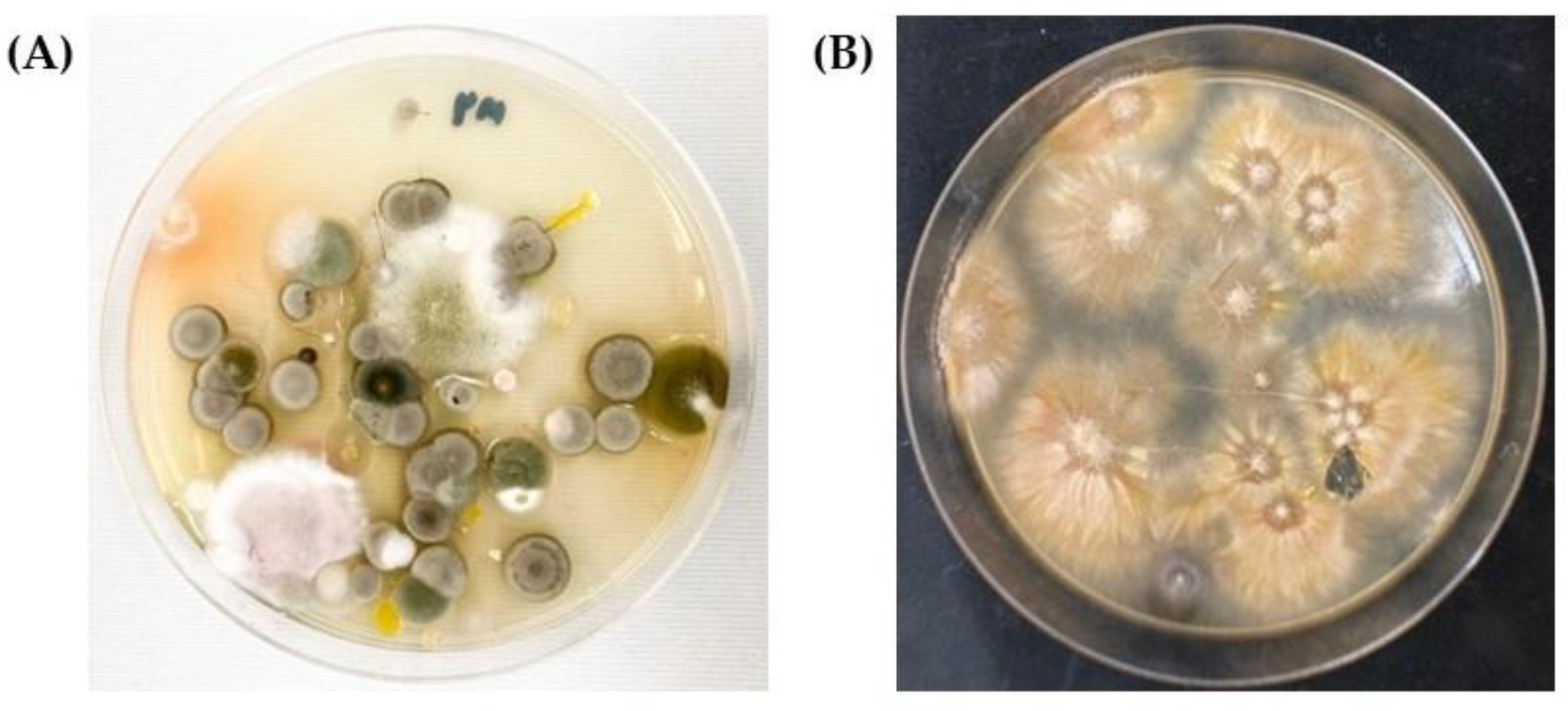Prevalence of Microsporum canis from Pet Cats in Small Animal Hospitals, Chiang Mai, Thailand
Abstract
:1. Introduction
2. Materials and Methods
2.1. Sample Collection
2.2. Fungal Identification
2.3. Confirmation of Species Using Molecular Techniques
2.4. Data Analysis
3. Results
3.1. Sample Collection
3.2. Fungal Identification
3.3. Confirmation of Species Using Molecular Techniques
4. Discussion
5. Conclusions
Author Contributions
Funding
Institutional Review Board Statement
Informed Consent Statement
Data Availability Statement
Acknowledgments
Conflicts of Interest
References
- Hoog, G.S.d.; Dukik, K.; Monod, M.; Packeu, A.; Stubbe, D.; Hendrickx, M.; Kupsch, C.; Stielow, J.B.; Freeke, J.; Göker, M.; et al. Toward a novel multilocus phylogenetic taxonomy for the dermatophytes. Mycopathologia 2017, 182, 5–31. [Google Scholar] [CrossRef] [Green Version]
- Zhan, P.; Dukik, K.; Li, D.; Sun, J.; Stielow, J.B.; van den Ende, B.G.; Brankovics, B.; Menken, S.B.J.; Mei, H.; Bao, W.; et al. Phylogeny of dermatophytes with genomic character evaluation of clinically distinct Trichophyton rubrum and T. violaceum. Stud. Mycol. 2018, 89, 153–175. [Google Scholar] [CrossRef]
- Vena, G.A.; Chieco, P.; Posa, F.; Garofalo, A.; Bosco, A.; Cassano, N. Epidemiology of dermatophytoses: Retrospective analysis from 2005 to 2010 and comparison with previous data from 1975. New Microbiol. 2012, 35, 207–213. [Google Scholar] [PubMed]
- DeBoer, D.J.; Moriello, K.A. Development of an experimental model of Microsporum canis infection in cats. Vet. Microbiol. 1994, 42, 289–295. [Google Scholar] [CrossRef]
- DeBoer, D.J.; Moriello, K.A. Investigations of a killed dermatophyte cell-wall vaccine against infection with Microsporum canis in cats. Res. Vet. Sci. 1995, 59, 110–113. [Google Scholar] [CrossRef]
- Moriello, K.A. Fungal flora of the haircoat of cats with and without dermatophytosis. J. Med. Vet. Mycol. 1991, 29, 285–292. [Google Scholar] [CrossRef]
- Verbrugge, M.; Moriello, K.; Newbury, S. Correlation of skin lesions and dermatophyte culture status in cats at the time of admission to a shelter. Vet. Dermatol. 2006, 17, 213. [Google Scholar]
- Newbury, S.; Blinn, M.K.; Bushby, P.K.; Cox, C.B.; Dinnage, J.D.; Griffin, B.; Hurley, K.F.; Isaza, N.; Jones, W.; Miller, L. Medical Health and Physical Well-Being. In Guidelines for Standards of Care in Animal Shelters; The Association of Shelter Veterinarians: Corning, NY, USA, 2010; pp. 15–30. Available online: http://www.sheltervet.org/assets/docs/shelter-standards-oct2011-wforward.pdf (accessed on 24 November 2021).
- Mackenzie, D.W.R. “Hairbrush diagnosis” in detection and eradication of non-fluorescent scalp ringworm. Br. Med. J. 1963, 2, 363–365. [Google Scholar] [CrossRef]
- Moriello, K.A. Diagnostic techniques for dermatophytosis. Clin. Tech. Small Anim. Pract. 2001, 16, 219–224. [Google Scholar] [CrossRef] [PubMed]
- Sutaphaha, B. Laboratory Identification of Pathogenic Fungi, 3rd ed.; Chiang Mai University press: Chiang Mai, Thailand, 2008; pp. 152–190. [Google Scholar]
- White, T.J.; Bruns, T.; Lee, S.; Taylor, J.W.; Innis, M.A.; Gelfand, D.H.; Sninsky, J. Amplification and direct sequencing of fungal ribosomal RNA genes for phylogenetics. In PCR Protocols: A Guide to Methods and Applications, 1st ed.; Innis, M.A., Gelfandm, D.H., Sninsky, J.J., White, T.J., Eds.; Academic Press: New York, NY, USA, 1990; pp. 315–322. [Google Scholar]
- Bernardo, F.; Lanca, A.; Guerra, M.M.; Martins, H.M. Dermatophytes isolated from pet, dogs and cats in Lisbon, Portugal (2000–2004). RPCV 2005, 100, 85–88. [Google Scholar]
- Willemse, T. Dermatophytosis and clinical management. In Proceedings of the 14th Chulalongkorn University Veterinary Conference (CUVC2015), Bangkok, Thailand, 20–22 April 2015; pp. 23–26. [Google Scholar]
- Romano, C.; Paccagnim, E.; Pelliccia, L. Case report. Onychomycosis due to Microsporum canis. Mycoses 2001, 44, 119–120. [Google Scholar] [CrossRef] [PubMed]
- Ginarte, M.; Pereiro, M., Jr.; Fernandez-Redondo, V.; Toribio, J. Case reports. Pityriasis amiantacea as manifestation of tinea capitis due to Microsporum canis. Mycoses 2000, 43, 93–96. [Google Scholar] [CrossRef] [PubMed]
- Sattasathuchana, P.; Bumrungpun, C.; Thengchaisri, N. Comparison of subclinical dermatophyte infection in short- and long-haired cats. Vet. World 2020, 13, 2798–2805. [Google Scholar] [CrossRef]
- Chupia, V.; Jirasarunyanon, P.; Sriwises, S.; Na Lampang, K.; Buranapim, N. Type of dermatophytes on rabbit skin in rabbit café in Chiang Mai. Vet. Integr. Sci. 2019, 17, 75–85. [Google Scholar]
- Kobwanthanakun, W.; Bunyaratavej, S.; Leeyaphan, C. Tinea corporis from Microsporum canis: A case report in 2 patients from 1 asymptomatic feline. Thai J. Dermatol. 2018, 34, 299–304. [Google Scholar]
- Boothe, D.M. Antifungal drugs. In Small Animal Clinical Pharmacology and Therapeutics, 2nd ed.; Saunders Elsevier: St. Louis, MO, USA, 2012; pp. 368–369. [Google Scholar]




| Cat | Number | Result | Number | Site | Number |
|---|---|---|---|---|---|
| With skin lesions | 43 | +M. canis | 18 | lesion and other site of body | 9 |
| body | 2 | ||||
| lesion | 7 | ||||
| −M. canis | 25 | - | - | ||
| Without skin lesions | 95 | +M. canis | 10 | body | 10 |
| −M. canis | 85 | - | - | ||
| Total | 28 | ||||
Publisher’s Note: MDPI stays neutral with regard to jurisdictional claims in published maps and institutional affiliations. |
© 2022 by the authors. Licensee MDPI, Basel, Switzerland. This article is an open access article distributed under the terms and conditions of the Creative Commons Attribution (CC BY) license (https://creativecommons.org/licenses/by/4.0/).
Share and Cite
Chupia, V.; Ninsuwon, J.; Piyarungsri, K.; Sodarat, C.; Prachasilchai, W.; Suriyasathaporn, W.; Pikulkaew, S. Prevalence of Microsporum canis from Pet Cats in Small Animal Hospitals, Chiang Mai, Thailand. Vet. Sci. 2022, 9, 21. https://doi.org/10.3390/vetsci9010021
Chupia V, Ninsuwon J, Piyarungsri K, Sodarat C, Prachasilchai W, Suriyasathaporn W, Pikulkaew S. Prevalence of Microsporum canis from Pet Cats in Small Animal Hospitals, Chiang Mai, Thailand. Veterinary Sciences. 2022; 9(1):21. https://doi.org/10.3390/vetsci9010021
Chicago/Turabian StyleChupia, Vena, Jirapat Ninsuwon, Kakanang Piyarungsri, Chollada Sodarat, Worapat Prachasilchai, Witaya Suriyasathaporn, and Surachai Pikulkaew. 2022. "Prevalence of Microsporum canis from Pet Cats in Small Animal Hospitals, Chiang Mai, Thailand" Veterinary Sciences 9, no. 1: 21. https://doi.org/10.3390/vetsci9010021
APA StyleChupia, V., Ninsuwon, J., Piyarungsri, K., Sodarat, C., Prachasilchai, W., Suriyasathaporn, W., & Pikulkaew, S. (2022). Prevalence of Microsporum canis from Pet Cats in Small Animal Hospitals, Chiang Mai, Thailand. Veterinary Sciences, 9(1), 21. https://doi.org/10.3390/vetsci9010021




